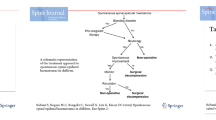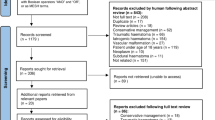Abstract
Purpose
This study aimed to elucidate the severity of neurological deficits in a large series of patients with acute spontaneous spinal epidural haematoma (SSEH) using magnetic resonance imaging (MRI).
Methods
We included 57 patients treated for acute SSEH at 11 institutions and retrospectively analysed their demographic and MRI data upon admission. We investigated MRI findings, such as the haematoma length and canal occupation ratio (COR). The neurological severity of SSEH was assessed based on the American Spinal Injury Association score on admission.
Results
Of the 57 patients, 35 (61%) presented with severe paralysis. The MRI analysis showed that SSEH was often located in the cervical spine, dorsal to the spinal cord, and spread over more than three vertebrae. No differences in age, sex, and aetiology were found between patients with and without severe paralysis. The hypo-intensity layer encircling the haematoma, intra-haematoma heterogeneity, and increased CORs were observed more frequently in the severe paralysis group. Furthermore, pathological examination of a dissected haematoma from one patient with a hypo-intensity layer revealed a collagen layer around the haematoma, and patients with intra-haematoma heterogeneity were more likely to have a bleeding predisposition.
Conclusions
In this large series of patients with SSEH, we identified some MRI features associated with severe paralysis, such as the hypo-intensity layer, intra-haematoma heterogeneity, and increased COR. Accordingly, patients with these MRI characteristics should be considered for early surgical intervention.






Similar content being viewed by others
Data availability
The datasets during and/or analysed during the current study are available from the corresponding author on reasonable request.
References
Jackson R (1869) Case of spinal apoplexy. Lancet 94:5–6. https://doi.org/10.1016/s0140-6736(02)67624-x
Groen RJM, Ponssen H (1990) The spontaneous spinal epidural hematoma A study of the etiology. J Neurol Sci 98:121–138. https://doi.org/10.1016/0022-510x(90)90253-j
Groen RJM (2004) Non-operative treatment of spontaneous spinal epidural hematomas: a review of the literature and a comparison with operative cases. Acta Neurochir 146:103–110. https://doi.org/10.1007/s00701-003-0160-9
Dziedzic T, Kunert P, Krych P, Marchel A (2015) Management and neurological outcome of spontaneous spinal epidural hematoma. J Clin Neurosci 22:726–729. https://doi.org/10.1016/j.jocn.2014.11.010
Matsumura A, Namikawa T, Hashimoto R, Okamoto T, Yanagida I, Hoshi M, Noguchi K, Takami M (2008) Clinical management for spontaneous spinal epidural hematoma: diagnosis and treatment. Spine J 8:534–537. https://doi.org/10.1016/j.spinee.2007.01.009
Groen RJM, van Alphen HAM (1996) Operative treatment of spontaneous spinal epidural hematomas: a study of the factors determining postoperative outcome. Neurosurgery 39:494–508. https://doi.org/10.1097/00006123-199609000-00012
Shin J-J, Kuh S-U, Cho Y-E (2006) Surgical management of spontaneous spinal epidural hematoma. Eur Spine J 15:998–1004. https://doi.org/10.1007/s00586-005-0965-8
Liao C-C, Hsieh P-C, Lin T-K et al (2009) Surgical treatment of spontaneous spinal epidural hematoma: a 5-year experience: Clinical article. J Neurosurg Spine 11:480–486. https://doi.org/10.3171/2009.4.spine08904
Liao C-C, Lee S-T, Hsu W-C, Chen LR, Lui TN, Lee SC (2004) Experience in the surgical management of spontaneous spinal epidural hematoma. J Neurosurg 100:38–45
Rajz G, Cohen JE, Harnof S, Knoller N, Goren O, Shoshan Y, Fraifeld S, Kaplan L, Itshayek E (2015) Spontaneous spinal epidural hematoma: the importance of preoperative neurological status and rapid intervention. J Clin Neurosci 22:123–128. https://doi.org/10.1016/j.jocn.2014.07.003
von Elm E, Altman DG, Egger M, Pocock SJ, Gøtzsche PC, Vandenbroucke JP, STROBE Initiative (2007) The Strengthening the Reporting of Observational Studies in Epidemiology (STROBE) statement: guidelines for reporting observational studies. Lancet 370:1453–1457. https://doi.org/10.1016/s0140-6736(07)61602-x
Roberts TT, Leonard GR, Cepela DJ (2017) Classifications in brief: American Spinal Injury Association (ASIA) Impairment Scale. Clin Orthop Relat Res 475:1499–1504. https://doi.org/10.1007/s11999-016-5133-4
Moriarty HK, Cearbhaill RO, Moriarty PD, Stanley E, Lawler LP, Kavanagh EC (2019) MR imaging of spinal haematoma: a pictorial review. Br J Radiology 92:20180532. https://doi.org/10.1259/bjr.20180532
Marhold F, Popadic B, Rechberger P, Berger-Brabec S, Decristoforo I, Sherif C, Scheichel F (2021) Extent of spinal canal obliteration as prognostic factor for functional outcome in patients with spontaneous spinal epidural hematoma: a retrospective study. Acta Neurochir 163:3279–3286. https://doi.org/10.1007/s00701-021-05011-x
Landis JR, Koch GG (1977) The measurement of observer agreement for categorical data. Biometrics 33:159–174
Holtås S, Heiling M, Lönntoft M (1996) Spontaneous spinal epidural hematoma: findings at MR imaging and clinical correlation. Radiology 199:409–413. https://doi.org/10.1148/radiology.199.2.8668786
Kreppel D, Antoniadis G, Seeling W (2003) Spinal hematoma: a literature survey with meta-analysis of 613 patients. Neurosurg Rev 26:1–49. https://doi.org/10.1007/s10143-002-0224-y
Tamburrelli FC, Meluzio MC, Masci G, Perna A, Burrofato A, Proietti L (2018) Etiopathogenesis of traumatic spinal epidural hematoma. Neurospine 15:101–107. https://doi.org/10.14245/ns.1834938.469
Nagata K, Oshima Y, Nakajima K, Higashikawa A, Ando T, Kobayashi A, Taniguchi Y, Matsubayashi Y (2019) Consecutive images of conservatively treated cervical spontaneous spinal epidural hematoma. J Clin Neurosci 59:270–275. https://doi.org/10.1016/j.jocn.2018.10.097
Dinauer PA, Brixey CJ, Moncur JT, Fanburg-Smith JC, Murphey MD (2007) Pathologic and MR imaging features of benign fibrous soft-tissue tumors in adults1. Radiographics 27:173–187. https://doi.org/10.1148/rg.271065065
Hentschel SJ, Woolfenden AR, Fairholm DJ (2001) Resolution of spontaneous spinal epidural hematoma without surgery. Spine 26:E525–E527. https://doi.org/10.1097/00007632-200111150-00025
Eming SA, Wynn TA, Martin P (2017) Inflammation and metabolism in tissue repair and regeneration. Science 356:1026–1030. https://doi.org/10.1126/science.aam7928
Smigiel KS, Parks WC (2018) Macrophages, wound healing, and fibrosis: recent insights. Curr Rheumatol Rep 20:17. https://doi.org/10.1007/s11926-018-0725-5
Bradley WG (1993) MR appearance of hemorrhage in the brain. Radiology 189:15–26. https://doi.org/10.1148/radiology.189.1.8372185
Author information
Authors and Affiliations
Contributions
Shintaro Honda, Takayoshi Shimizu, and Shunsuke Fujibayashi contributed to the study’s conception and design. Material preparation and data collection were performed by Shintaro Honda, Naoya Tsubouchi, Yusuke Kanba, Takashi Sono, Hiroaki Kimura, Seichi Odate, Eijiro Onishi, Yasuyuki Tamaki, Takuya Tomizawa, Ryosuke Tsutsumi, and Ko Yasura. The first draft of the manuscript was written by Shintaro Honda and all authors commented on previous versions of the manuscript. All authors read and approved the final manuscript. All authors certify that they have no affiliations with or involvement in any organization or entity with any financial interest or non-financial interest in the subject matter or materials discussed in this manuscript.
Corresponding author
Ethics declarations
Ethics approval
All procedures performed in this study were in accordance with the ethical standards of the institutional ethics committee of Kyoto University (IRB number R2901, March 18, 2021), and with the 1964 Helsinki Declaration and its later amendments or comparable ethical standards.
Consent to participate and for publication
Written informed consent to participate in this study was waived due to the retrospective observational nature of this study, and no identifiable information of the participants was included in the manuscript. Patients signed informed consent regarding publishing their data and photographs.
Competing interests
The authors declare no competing interests.
Additional information
Publisher's note
Springer Nature remains neutral with regard to jurisdictional claims in published maps and institutional affiliations.
Rights and permissions
About this article
Cite this article
Honda, S., Fujibayashi, S., Shimizu, T. et al. Neurological severity evaluation using magnetic resonance imaging in acute spontaneous spinal epidural haematomas. International Orthopaedics (SICOT) 46, 2347–2355 (2022). https://doi.org/10.1007/s00264-022-05513-y
Received:
Accepted:
Published:
Issue Date:
DOI: https://doi.org/10.1007/s00264-022-05513-y




